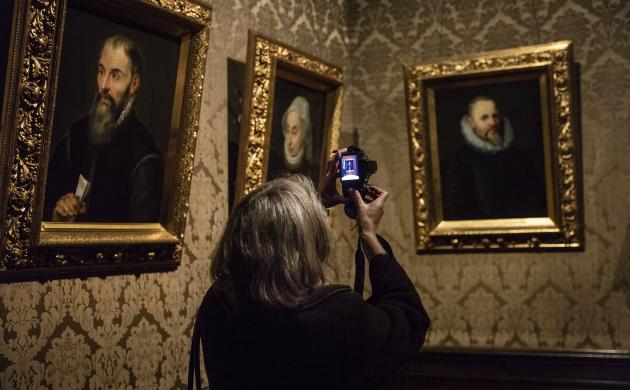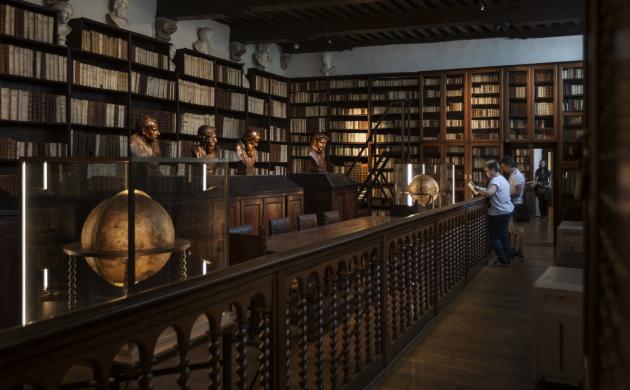Before Plantin relocated his business to Vrijdagmarkt, he worked in various houses and buildings (circa 1548-1576).
The history of the Officina Plantiniana on Vrijdagmarkt extends over three centuries (1576-1876). There were also further changes to the building after 1876, when it was organised as a museum.
Earlier houses and buildings
- The period 1548-1576: first buildings of the Officina Plantiniana
- 1548-1549: Plantin lives and works as a bookbinder on Lombardenvest, in the city quarter where most book printers and booksellers are based.
- 1552: Plantin moves to Twaalfmaandenstraat and sets up his first printing press there. The first work that he prints and publishes in 1555 is La Institutione di una Fanciulla Nata Nobilmente.
- 1557: Plantin moves to Kammenstraat, the printers’ quarter. He settles in the house ‘De Gulden Eenhoorn’ (‘The Golden Unicorn’). In 1558 he prints 25 books there.
- 1560: in the former grounds of the brewery ‘De Witte Valck’ near Kammenstraat, new streets are created, including Bergstraat and Valkstraat – now Gierstraat. Plantin’s printing business also moves to this new development.
- 1562-1563: Plantin flees to Paris. All his possessions are sold on the Vrijdagmarkt, but with the support of partners he is able to resume his business in Kammenstraat in September 1563.
- 1564-1565: Plantin’s business is successful, and he rents three other houses on Kammenstraat. In 1561, his business is renamed ‘De Gulden Passer’ (‘The Golden Compasses’). The number of presses at the premises increases to six in 1565 and seven in 1566. Plantin’s business starts growing continuously from this point.
- 1568-1573: Plantin’s business is bursting at the seams. The printing press expands, occupying seven houses near Kammenstraat. Here, between 1568 and 1573, he prints the famous Biblia Polyglotta or Biblia Regia. In one of the houses, named ‘Daalder’, Plantin’s son-in-law Franciscus Raphelengius has a room just 3.5 m wide and 4.5 m long, in which the whole family works, eats and sleeps.
Vrijdagmarkt
- The period 1576-1876: the Officina Plantiniana complex on Vrijdagmarkt
- 1576: Plantin settles in a building with an entrance on Hoogstraat, which he renames ‘De Gulden Passer’ (‘The Golden Compasses’). This establishment is large enough for him to set up sixteen presses and live comfortably there. There is also a large garden. The Spanish Fury reduces printing activity: in January 1577, Plantin only has three presses still in operation.
- 1579: Plantin becomes the owner of a house with an entrance on Vrijdagmarkt. It has a large garden at the back and a coach house with an entrance on Heilige Geeststraat. In the back corner of his garden, adjacent to the canal, he sets up his new printing shop next to his home. In 1578 and 1579, Plantin has five or six presses in operation again.
- 1579-1580: Plantin starts building three dwellings and converting the old coach house into a fourth, all on Heilige Geeststraat. He calls them ‘The Silver Compasses’, ‘The Copper Compasses’, ‘The Iron Compasses’ and ‘The Wooden Compasses’. The houses are partially rented out as investment properties. Meanwhile, the printing works is doing better again: there are seven presses operating again in 1580, and eight in 1581.
- After 1580: shortly after gaining permission to cover the adjacent canal, Plantin also builds another residential property on Vrijdagsmarkt.
- 1582-1583: the Siege of Antwerp is in prospect, and there is an urgent need for a properly equipped printing works in the young university town of Leiden. Plantin buys a large house there in 1582. In late April 1583 he emigrates to the new branch with his wife and several of his employees. There he becomes the official academic printer on 12 May. His sons-in-law Jan I Moretus and Francis Raphelengius stay in Antwerp to run the parent business.
- 1585: following the city’s capitulation on 17 August, Plantin returns immediately to Antwerp to become the main printer-publisher of the Counter-Reformation there.
- 1589: after Plantin’s death, Jan I Moretus, who has been married to Martina Plantin since 1570, continues the business in Antwerp. Plantin’s eldest daughter Margaretha has fled to Leiden with her husband Raphelengius in 1586, and inherits the printing works there. The other daughters, Catherina, Magdalena and Henrica, each inherit one of the ‘compasses’ houses: the Iron, Wooden and Silver Compasses.
- 1620-1640: under Balthasar I Moretus, the Officina Plantiniana assumes its present-day form in the years 1621-1622 and 1637-1639. The building is enlarged: the floor above the works is created, and the east wing and the proof-readers’ room are added. The courtyard acquires its present-day appearance and the interior is decorated, including the establishment of the large library with accompanying chapel.
- 1620: after the acquisition by Jan I Moretus of ‘The Wooden Compasses’ in 1608, Balthasar I Moretus also regains possession of ‘The Iron Compasses’. In 1620 he also buys the house next to ‘The Wooden Compasses’ on Heilige Geeststraat, ‘Het Vosken’ (‘The Fox’). He hides the rear façades along Heilige Geeststraat behind a Tuscan gallery.
- 1635: Balthasar I Moretus becomes the owner of the house ‘De Bonte Huyt’ on Hoogstraat. The rear of the house adjoins the courtyard, and he also connects the L-shaped Tuscan gallery to this building.
- 1639: Balthasar I Moretus brings the bookshop, previously located on Kammenstraat, to ‘The Golden Compasses’ on Vrijdagmarkt. The shop is installed in the west wing where the proof-readers’ room is now located, away from the printing works. Customers reach it by passing through the courtyard.
- In around 1700, the bookshop moves to its current premises on Heilige Geeststraat. Potential buyers no longer need to enter the courtyard, which suits the greater need for privacy experienced by the Moretus family, who have by now been elevated to the nobility.
- 1761-1763: Franciscus Joannes Moretus has the medieval façades demolished on the seven small houses still extant. These are next to the entrance gate on Vrijdagmarkt.
- 1798: the Moretus family is able to repurchase ‘The Copper Compasses’.
- 1819: as the final link in the chain, the Moretus family repurchases ‘The Silver Compasses’ – the house built by Plantin but subsequently sold.
Changes from 1876
- The period 1876 to the present: the Museum Plantin-Moretus.
- 1876-1877: The whole property is sold by jonkheer Edward Moretus on 20 April 1876 for the establishment of a museum. The buyer is the City of Antwerp, with support from the Belgian State. Following renovation work, the Plantin-Moretus Museum is opened to the public on 19 August 1877.
- On the corner of Heilige Geeststraat, a broad new house in neo-classical style is built as an extension of the frontage on Vrijdagmarkt. The two buildings are connected internally. This three-storey corner property is officially opened on 11 March 1939 as the Municipal Print Room. Today it houses the Museum’s exhibition hall, the stores of the Print Room and the reading room with its specialised library relating to the graphic collections.
- 1940-1945: during the Second World War, the library, its entire contents and all valuable items are packed away in a huge series of chests. Initially, these are stored in the chateau of Lavaux-Sainte-Anne in the province of Namur. Then, shortly before the Battle of the Bulge, they are moved to the cellars of the National Bank in Brussels.
- 1945: on 2 January, a V2 bomb lands, destroying all the houses on Vrijdagmarkt. The whole museum complex on Vrijdagmarkt narrowly escapes complete destruction. The museum’s east wing is badly damaged, but restoration is possible.
- 1947-1951: restoration work starts on behalf of the City of Antwerp. On 28 July 1951, the restored complex with a renewed and permanent display is reopened to the public.
- 1951: a higher institute for graphic arts is established in the museum: the Plantin Society. The Society works to improve knowledge of printing in general and the typographical quality of Flemish books within the context of the museum. It introduces a teaching cycle with the support of the commercial printing sector.
- 1980: the corner house between Vrijdagmarkt, Vrijdagmarktstraatje and Steenhouwersvest, which was almost completely destroyed in 1945, is replaced by a new building with business premises by order of the City of Antwerp. The building is constructed on the still extant 16th-century cellars.
- 1990: the former gatehouse at 8 Heilige Geeststraat is purchased. It becomes a storage space for the museum shop’s stock and exhibition materials. It also houses part of the modern museum archive. In 1995, part of the ground floor is opened to the public.
- 1992-1993: in the context of ‘Antwerp, European Capital of Culture 1993’, the courtyard is replanted with plants and herbs that were cultivated around 1600. The idea is ensure the greatest possible harmony between architectural heritage and garden design.
- 1997-1998: the large roof space in the Vrijdagsmarkt wing is converted into an auditorium. The Christoffel Plantin Auditorium is officially opened on 4 June 1998. It includes a teaching and meeting room, library infrastructure and an office. Henceforth, courses are taught there every Saturday, organised by the Plantin Society.
- 1999: the reception area is redeveloped. To the rear, a cloakroom with toilet facilities is added. The original furniture is transferred to the first floor. There, a new walkway is brought into use in 1999-2000, linking the 18th-century wing on Vrijdagmarkt with the 17th-century library in the south wing.
- 2000-2002: the façades of the historic courtyards are restored. On the first floor of the east wing, the window is recreated in the wall of the curator’s room. It had been bricked up in around 1876. This room in Flemish Renaissance style is taken into use as an office by the director-curator in July 2001.
- 2002: an ‘educational cottage’ for the organisation of workshops is created in a property to the rear dating from 1876-1877. This was erected in neo-Renaissance style on a plot on the Hoogstraat.
- 2002: the land over the canal, which has previously been left undeveloped, is used to create a second courtyard next to the reception area. During the 19th century, the old canal, which originally ran past Plantin’s printing works, was covered over. The garden design is developed by the renowned Belgian landscape architect Wirtz.
- 2002: the 18th-century dining room in the stairwell is restored to its original state. The work includes reinstating the restored 18th-century murals with scenes from rural life by Theodoor De Bruyn.
- 2002: the Salon Emile Verhaeren-René Vandevoir is opened in premises in the 18th-century front section of the building on the first floor.




